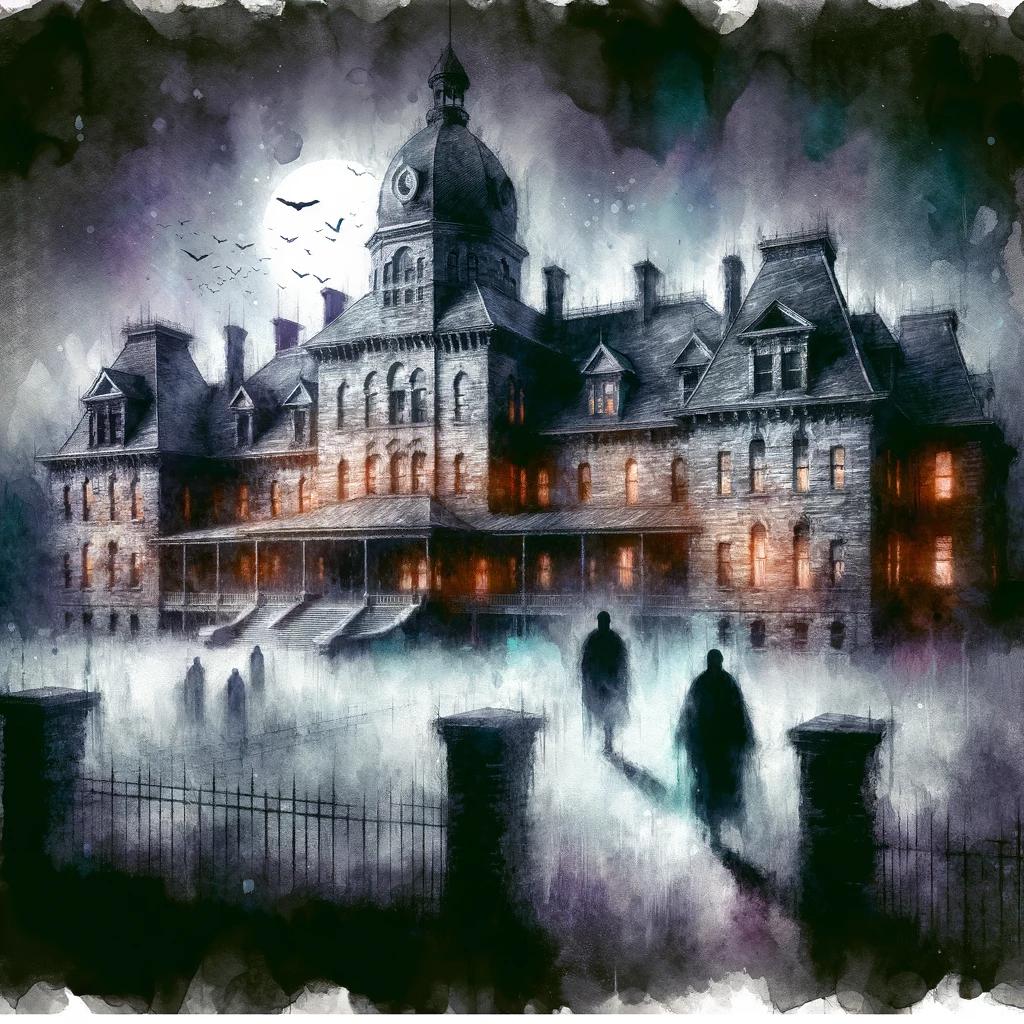Introduction
“Ting. Tingle, tingle, tremble toes, she’s a good fisherman, catches hens, puts ‘em in a pens… wire blier, limber lock, three geese in a flock…” These hauntingly whimsical words from “One Flew Over the Cuckoo’s Nest” reflect the complex and often dark history of mental healthcare, a theme poignantly embodied by the Trans-Allegheny Lunatic Asylum.
Located in West Virginia, this imposing structure stands as a relic of a bygone era in psychiatric treatment. Opened in the mid-19th century and operational for over a century, the asylum witnessed the evolution and many missteps of mental health care. Today, it is shrouded in tales of the supernatural, with its long, echoing hallways and abandoned wards said to be haunted by the spirits of past patients. As we step into the world of the Trans-Allegheny Lunatic Asylum, we uncover stories not just of hauntings, but of humanity – a testament to the lives that passed through its doors and the changing tides of mental health practices.
History
The Trans-Allegheny Lunatic Asylum, located in Weston, West Virginia, has a long and complex history that spans over a century. Construction of the asylum began in 1858, and it was originally designed to house 250 patients. However, due to delays caused by the outbreak of the Civil War, the asylum was not completed until 1881, and by then, its capacity had increased to accommodate over 2,400 patients, making it one of the largest mental institutions in the country.
The design of the Trans-Allegheny Lunatic Asylum was based on the Kirkbride Plan, a revolutionary approach to mental healthcare developed by Dr. Thomas Story Kirkbride. The plan emphasized providing a tranquil and therapeutic environment for patients, believing that beautiful and well-kept surroundings could aid in their recovery. The asylum’s architecture, with its imposing Gothic Revival style and spacious grounds, aimed to create an atmosphere of calm and tranquility.
In the 1900s, the asylum’s name was changed to Western State Hospital to reflect its location in West Virginia. Despite efforts to improve conditions over the years, the hospital faced ongoing challenges and criticism. The introduction of psychotropic medications in the mid-20th century led to a decline in the asylum population, as more patients were treated in community settings. Western State Hospital finally closed its doors in 1994, marking the end of an era in mental healthcare.

Today, the Trans-Allegheny Lunatic Asylum stands as a solemn reminder of the challenges and progress in the field of mental healthcare. Its impressive architecture, storied history, and haunted legends continue to draw visitors from around the world, making it a unique and evocative destination for those seeking to explore its past and contemplate the complexities of mental health treatment throughout history.
Haunting Legends and Supernatural Phenomena
The Trans-Allegheny Lunatic Asylum holds within its walls a history filled with tragic and paranormal events. Here are a few chilling stories that have etched themselves into the asylum’s dark legacy:
- The Shadows of Elizabeth: Elizabeth, a young patient at the asylum, fell victim to the harsh conditions and inadequate care. It is said that her tormented spirit still wanders the halls, appearing as a shadowy figure to those who dare to enter. Witnesses have reported feeling an overwhelming sense of sadness and hearing her desperate cries echoing through the asylum’s corridors.
- The Tragic Fire: In 1935, a devastating fire swept through the asylum, claiming the lives of several patients. The charred remains of the building serve as a haunting reminder of the tragedy that unfolded within its walls. Visitors have reported witnessing apparitions and hearing ghostly screams reminiscent of the souls lost in the fire.
- Doctor’s Dark Experiments: Dr. Walter Freeman, a notorious psychiatrist known for his controversial lobotomy procedures, performed experiments on patients at the asylum. The residual energy of these disturbing procedures is believed to linger, manifesting as chilling cries and unsettling sensations for those who explore the asylum’s treatment rooms.
- The Ghostly Matron: Matron Harriet, a stern figure responsible for overseeing the asylum, has been sighted by visitors. Her spectral presence often evokes feelings of fear and unease. Witnesses have reported hearing her footsteps echoing through the hallways, as if she continues her duties even in the afterlife.

The Spirit of Dean
In the eerie halls of Trans-Allegheny Lunatic Asylum, a chilling tale unfolds. Meet Dean, a tormented soul caught in the clutches of horror. His tragic fate intertwined with two infamous inmates: Big Jim and David Mason, the asylum’s most dangerous men.
Driven by malevolence, the duo hatched a sinister plan. They relentlessly tried to hang Dean, but fate intervened. Until that fateful day when darkness triumphed. With merciless force, they pushed Dean’s head beneath the bedpost, snuffing out his life.
Now, Dean’s spirit roams in silence, haunted by the shadows of his tormentors. Whenever Big Jim and David emerge, an unsettling shift envelopes the room, leaving visitors ill at ease.
Witness the echoes of horror as Dean’s restless presence etches its mark on the asylum’s history. Step into the legend, and experience the chilling legacy that lingers within its walls.
The Lobotomy Horror
In the eerie halls of the Trans-Allegheny Lunatic Asylum, a terrifying chapter unfolded—the era of experimental lobotomies. Over 4,000 of these gruesome procedures were conducted, leaving some patients with devastating brain damage and fatal hemorrhages.
The infamous “ice pick” method involved piercing a thin rod into the eye socket and hammering it to sever the frontal lobe of the brain, leading to unimaginable suffering and death. The asylum’s walls hold the chilling echoes of this haunting past, a grim reminder of the pain endured within.
Venture into this haunted asylum, where the shadows conceal the tragic legacy of those who fell victim to these nightmarish experiments. Prepare to confront the sinister history etched into the very fabric of this dark and haunted place.
Ghost of Lily
In the ghostly halls of Trans-Allegheny Lunatic Asylum, a heartwarming tale unfurls—the enchanting spirit of Lily. Believed to have spent her entire life within the asylum’s embrace, her presence has endured through the ages.
Gladys, a victim of cruel fate, sought refuge within these walls after a supposed assault by civil war soldiers. Her harrowing journey took an even darker turn when she became pregnant. Tragically, childbirth claimed her life, leaving her infant daughter alone.
However, at the tender age of nine, pneumonia stole Lily away, shattering hearts but not her spirit. To this day, visitors pay homage to Lily, leaving behind toys, stuffed animals, and candy. Inexplicably, these gifts move and vanish—Lily’s playful way of connecting with the living.
As a testament to the past, expectant mothers sought solace within these walls, giving birth to their babies while under the asylum’s care. It was here that Lily found her home, and her playful laughter echoes through time.
A child spirit, she revels in games, captivating both staff and visitors with her friendly demeanor. A perpetual part of the asylum’s community, Lily reminds us that even in the shadows of the past, warmth and innocence can linger.
Slewfoot: The Sinister Enigma
In the darkened realm of Trans-Allegheny Lunatic Asylum, one name sends shivers down spines—Slewfoot. A shadowy figure cloaked in mystery, his nickname remains an enigma, lost in the annals of time.
Legends speak of his terrifying reign, haunting the upper floors with merciless intent. Some say he tortured and murdered his victims in the dreaded upstairs bathroom, leaving a trail of horror in his wake.
Slewfoot’s malevolence lingers, his spectral form said to roam the desolate corridors, unleashing chilling screams that reverberate through the night. His haunting presence imposes fear upon all who dare cross his path.
Isolation Cell

Asylum staff wielded immense power, banishing unruly patients to a terrifying isolation. Locked away at their mercy, these souls would endure anything to escape the desolation.
A fierce tale stands out—the ex-boxer, once a formidable force, now a casualty of head injuries. With emotion stripped away, he sought liberation, tearing off the metal door, leaving indelible dents in the steel. A chilling feat that left nurses speechless.
Venture into the heart of darkness, where violent energies linger, assaulting the senses. Visitors report being pushed, scratched, and tormented by eerie disembodied voices pleading for freedom.
Popular Culture and Media Coverage
The Trans-Allegheny Lunatic Asylum in Weston, West Virginia, once the largest hand-cut stone masonry building in North America, has loomed large in the public imagination due to its ominous history and reports of paranormal activity. It has made a significant impact on pop culture and media over the years.
Numerous paranormal television series have chosen the asylum as their investigation site, including popular shows like “Ghost Adventures” and “Ghost Hunters.” These programs’ explorations have uncovered various unexplained phenomena, reinforcing the building’s reputation as a haunted location.
The asylum’s chilling ambiance and unsettling past also inspired the setting for Bethesda’s video game “Fallout 76,” bringing its eerie allure to the world of gaming. It’s become a staple of the paranormal and horror genre, drawing thrill-seekers and ghost hunters alike.
Having delved into the history of the Trans Allegheny Lunatic Asylum, you may find your curiosity piqued by the haunting tales that surround this intriguing place. If so, “The Haunted History of the Trans Allegheny Lunatic Asylum“ by Sherri Brake is a must-read. Brake’s exploration goes beyond the mere facts, diving into the eerie accounts and supernatural occurrences reported within the asylum’s walls. Her engaging storytelling blends historical insight with chilling narratives, creating a reading experience that’s as informative as it is thrilling. Whether you’re a paranormal enthusiast or simply drawn to this unique piece of history, this book will provide a captivating continuation of your exploration of one of America’s most haunted locations.
Today, the Trans-Allegheny Lunatic Asylum offers historical and paranormal tours, attracting a steady stream of visitors. The site’s continuous presence in pop culture, from television to video games, attests to our enduring fascination with places that merge history with the paranormal.
Conclusion
The Trans-Allegheny Lunatic Asylum stands as a somber reminder of Weston’s past and the troubling treatment of mental illness in the 19th and early 20th centuries. As visitors step into the asylum’s shadowy corridors, they are transported to a time of anguish and suffering.
The eerie encounters and paranormal phenomena that persist within the asylum’s walls continue to both intrigue and unsettle those who dare to explore its haunted halls.
Frequently Asked Questions (FAQs) about the Trans-Allegheny Lunatic Asylum
Q1: Where is the Trans-Allegheny Lunatic Asylum located?
The Trans-Allegheny Lunatic Asylum is located in Weston, West Virginia.
Q2: When was the Trans-Allegheny Lunatic Asylum built?
The asylum was constructed in the mid-19th century.
Q3: Is the Trans-Allegheny Lunatic Asylum open to the public?
Yes, the Trans-Allegheny Lunatic Asylum is open to the public and offers guided tours.
Q4: What paranormal experiences have been reported at the asylum?
Visitors have reported sightings of ghostly apparitions, hearing disembodied voices, witnessing light anomalies, and experiencing feelings of unease within the Trans-Allegheny Lunatic Asylum.
Q5: What is the historical significance of the Trans-Allegheny Lunatic Asylum?
The asylum represents a significant part of the history of mental health care in the United States and serves as a preserved historical site to educate visitors about its troubled past.






